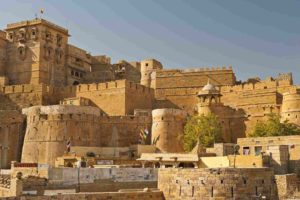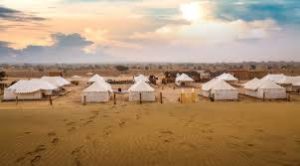Jaisalmer
One of the most magnificent attractions is the Jaisalmer Fort, also known as “Sonar Qila,” due to the yellow stone with which it was built.
Ghadsisar (Lake): is a rainwater lake which supplies water to the city. Sar means a lake. King Ghadsi of Jaisalmer got it made 650 years ago with the help of the people. It is surrounded by temples and tombs of saints. Boat rides are offered. Nearby is the desert cultural centre and a local museum built out of the collections of a local schoolteacher, Mr. N.K. Sharma. This centre conducts puppet shows in the morning and evening. There are people who will try and sell you bread to feed the huge number of catfish in the lake.
Jaisalmer Fort: Colourful shades of the setting sun and golden hues of the desert ambience give a fairy tale look to this mega structured fort. The interior of the fort is amazing. It is a ‘working fort,’ meaning that unlike every other fort in India, there are people living and working within its walls. Tourists can also visit many havelis of rich merchants, which are also having a touch of great classical interior and design.
There are numerous lookouts (at least five) within the fort that give a great view out across the city and desert.
A tour of the royal section of the fort is available from a starting point just to the right up the stairs as you enter the main square of the fort). The audio tour takes about one hour and 15 to 30 minutes. At the final few sections, there are two advertisements in it – not a must, the view is what you come for. It is however not possible anymore to opt out of the audiotour, it is included in the Rs 500 ticket (July 2015). They do charge Rs 100 extra per camera.
Jain Temple: There are seven beautifully carved temples built inside the fort walls. These temples were built between the 12th century to 15th century. All the temples are connected by walkways and corridors. It is compulsory to remove your shoes and all other leather articles (belts, wallets, purses, etc.) before entering any Jain temple. The very first temple which a tourist can visit is dedicated to Chandraprabhu, who is the eighth tirthankar (Jain God). The symbol of the God Chandraprabhu is the moon. This temple was built in 1509. It is built with fine stones. They are only open from 8am to midday. Leave a good hour to see them. Entry is Rs 200 (including camera). Take your shoes off and leave them near where you bought the tickets (a small tip is welcomed).
Havelis: Patwon-ki-Haveli is a ten-minute walk from the main gates of the fort and quite magnificent. It’s a collection of five houses, each one for the son of a wealthy trader who made money lending to the government. One of the havelis (closest to the street) has been restored and turned into a government museum. Expect to spend two hours there. Great view back towards the fort. Entry Rs 500 (foreign tourist). Guides wait around outside and offer their services for as little as Rs 50. However, they offer a rushed tour, and there is plenty of information on signs inside.
Renovated streets and houses: The city is currently undergoing quite extensive renovations, and particularly the small streets on the way to the Patwon-ki-Haveli have been redone with many houses now showing off exquisitely carved front sandstone walls. The houses are much more intricate and interesting from street level than they appear from the fort




So travel with Reliable Tour & Travel
Reliable Tour & Travel
C-4, Ambabari, Jaipur-302039 (Rajasthan)
Mob No.-9660779266, 9414522671
Website: www.reliabletourtravel.com